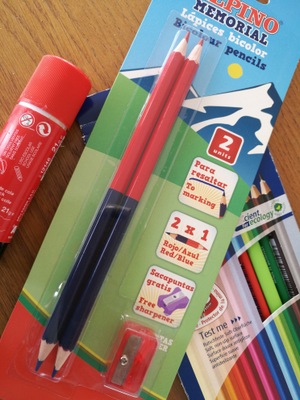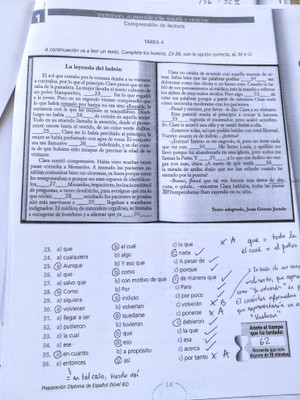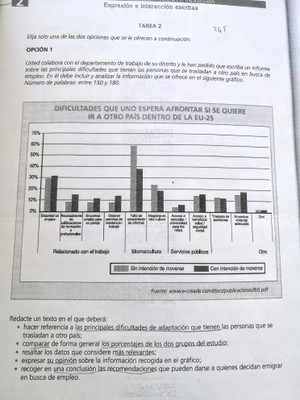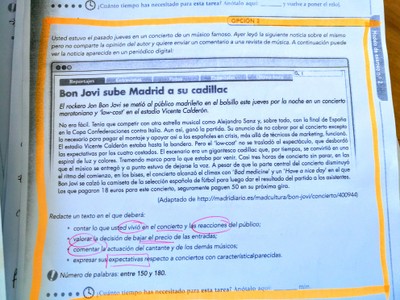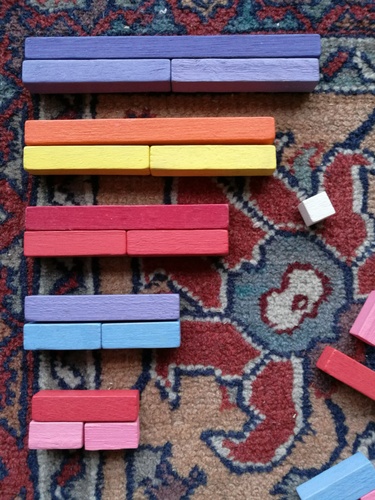El Cronómetro – Edición Nuevo DELE B2
I got this book about 2.5 months before the exam which, I have to be honest, is not enough. Unless, of course, you are studying Spanish full-time and are lucky enough to focus on one project at a time. I imagine this is highly unlikely if you are reading my blog (or rather, my hotchpotch of child education, multilingualism, parental stress and blank spaces) instead of one of those super-focused, determined, ambitious, successful blogs Linkedin keeps throwing in our faces.
THE OBJECTIVE
El Cronómetro is not a book for learning Spanish; instead it aims to teach you how to squeeze your existing knowledge in to the shape of the DELE exam. The book cost me about 20 euros. Given that it is not the first edition, I was surprised to still find a few inaccuracies and typos which I thought ought to have been smoothed out by now. More on that later.
THE CONTENTS
This book includes 4 model exam papers, a CD, and the answers (claves). Four may not seem a lot. However, bear in mind that one of the writing exam tasks has two options, meaning you can try out a total of 12 writing tasks using this book. The CD provides the listening exams and the oral prompts. Private Spanish language schools will usually provide you with past exam papers (- ask before you sign up -) but if you are doing things on the cheap like me and taking municipal classes or no classes at all, you really need to get hold of some old papers along with the couple that can be found online.
Personally I find there is nothing better than sitting mock exams to prepare you for timing and content. You can correct yourself using the answers included in the book for the listening and reading tests. I liked the idea of the Resumen de la preparación, where you record your scores. Hopefully you should see an improvement as you work through both the exam papers and extra exercises, though I didn’t see much probably because of only spending two months with the book. I only filled in my overall scores for each of the reading and listening tests I did, as I couldn’t really grade my writing and oral prep. Having boxes for my grade in each exercise (tarea) of each test was overkill for me, and I noticed that the headings (Lectura, etc) were missing.
Of course there are no answers for the writing and oral tests but I paid a friend to correct my writing exam prep, and I figure it was a very worthwhile investment. Although I didn’t have actual grades for these parts, it was still helpful to tick off the exercises in the resumen table as I completed them.
After the old exam papers there’s an appendix of exercises. This section is practically the last half of the book, almost as long as the model exams. The exercises are divided into three sections linked to the reading, listening and writing tests. I genuinely found these helped to develop one skill or another for the exam, along with a fair amount of vocab and grammar reminders. Again, the answers are included so you can correct yourself, and isolate and eliminate your failings be that por vs para or Latin American accents or whatever. Some exercises were a bit bland. I also didn’t feel inclined to note my opinion down about all sorts of things, as encouraged by the book. The author recommends you do the exercises prior to and in between the model exams. I didn’t have time to do most of them before (reminder: two months of normal-commitments life is not enough!) and chose to focus on the test papers instead, but after the exam I did them as I’m sure I’d need these issues resolved before the C1 exam.
GOOD ORAL PROMPTS
I thought the book wouldn’t help much for the Oral, but fortunately I was wrong. I found that the simulated oral prompts on the CD were as good as you could expect in terms of a substitution for a living breathing native Spanish speaker with time on their hands to help you practise the oral exam. The book suggests you record your speaking, and I found this a really good idea. I used the app Easy Voice Recorder on my phone and it was dead simple. I couldn’t bear to listen to the recordings much, but just the fact that I was recording made me continue talking instead of trailing off, or starting over, which really isn’t an option in the real thing. With one hand I’d play and pause the CD to get the examiner’s questions, and with the other I’d record on my phone, and it resulted in a better simulation than I had thought.
ANNOYING ERRORS
There were a few printing errors (typos, and more, eg p. 135) and also one of the recordings of the exercises was done with the wrong person speaking the wrong lines, but it was a practice exercise, not one of the exam tasks (pista 51, p. 158).
ALL IN ALL…
Overall this book was worth the money. It is good for when you feel you already have the knowledge for the exam but need to practise writing/talking with prompts and keeping to exam time; it helps you identify which of your weaknesses you need to improve to pass.
Disclaimer: I benefit in no way whether you buy the book through a link you find here or not. I write purely out of linguistic interest and unfortunately cannot be bothered to monetise.













